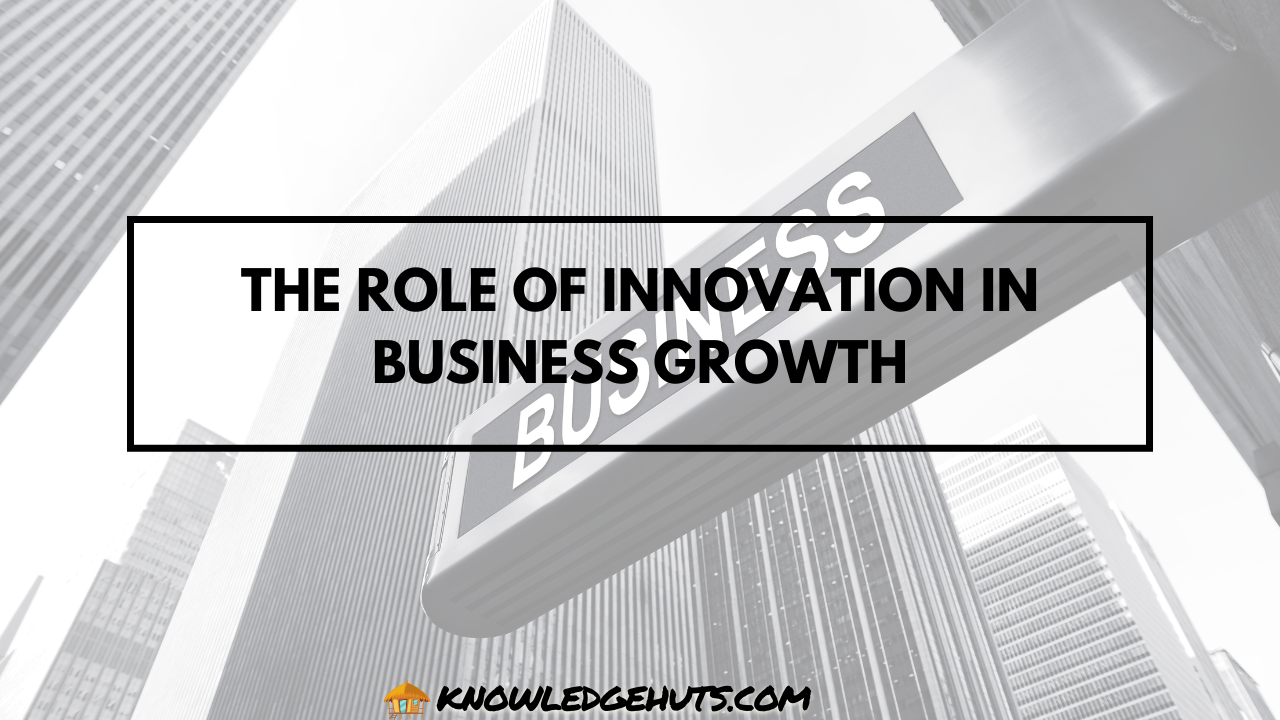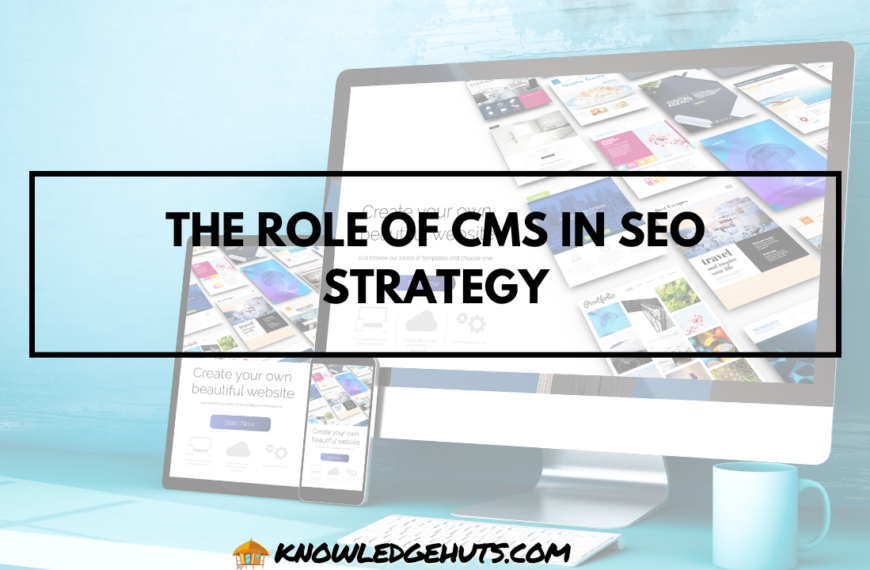Innovation is the lifeblood of any thriving business. In an increasingly competitive and rapidly changing market, innovation is not just a buzzword; it is a critical driver of business growth and long-term success. Companies that prioritize innovation are better positioned to adapt to market changes, meet evolving customer needs, and create new opportunities for growth.
In this blog post, we will explore the role of innovation in business growth, examining how it drives competitiveness, fosters efficiency, enhances customer satisfaction, and ultimately leads to sustained success. We’ll delve into the different types of innovation, strategies for fostering an innovative culture, and the impact of innovation on various aspects of a business. Additionally, we’ll provide real-world examples, relevant quotes, and actionable insights to help businesses harness the power of innovation.
Understanding Innovation in Business
Innovation in business refers to the process of introducing new ideas, products, services, or processes that add value to the company and its customers. It is about doing something different that creates value, whether by improving existing offerings, introducing new technologies, or finding more efficient ways to operate.
Types of Innovation
- Product Innovation: Introducing new or significantly improved products or services. This can include developing entirely new products, enhancing existing ones, or expanding product lines to meet new customer needs.
- Process Innovation: Improving internal processes to enhance efficiency, reduce costs, or increase quality. This type of innovation often involves adopting new technologies, streamlining operations, or reengineering workflows.
- Business Model Innovation: Changing the way a business creates, delivers, or captures value. This can involve introducing new revenue streams, altering the supply chain, or adopting a subscription model instead of a traditional sales approach.
- Organizational Innovation: Implementing new organizational structures, cultures, or management practices that improve a company’s ability to innovate and respond to market changes.
Quote: “Innovation is the ability to see change as an opportunity – not a threat.” — Steve Jobs
Example Table: Types of Innovation and Their Impact on Business
| Type of Innovation | Description | Impact on Business Growth |
|---|---|---|
| Product Innovation | Development of new or improved products/services | Drives market share growth, meets customer needs |
| Process Innovation | Enhancing internal processes for better efficiency | Reduces costs, improves quality and productivity |
| Business Model Innovation | Changing how a business creates/delivers value | Opens new revenue streams, increases competitiveness |
| Organizational Innovation | New structures or cultures to foster innovation | Improves adaptability, enhances employee engagement |
The Role of Innovation in Driving Competitiveness
In a world where markets are dynamic and consumer preferences constantly evolve, maintaining a competitive edge requires continuous innovation. Companies that fail to innovate risk becoming obsolete as new technologies and competitors emerge.
How Innovation Enhances Competitiveness
- Market Differentiation: Innovation allows businesses to differentiate themselves from competitors by offering unique products, services, or experiences. This differentiation can attract new customers and retain existing ones, leading to increased market share.
- First-Mover Advantage: Innovating early in a market can provide a first-mover advantage, allowing a company to establish itself as a leader before competitors enter the space. This can lead to brand recognition, customer loyalty, and the ability to set industry standards.
- Adaptability to Market Changes: Innovation equips businesses with the tools and mindset to quickly adapt to changes in the market. Whether it’s shifting consumer preferences, new regulations, or technological advancements, innovative companies can pivot more effectively than those stuck in traditional ways of doing business.
- Cost Leadership: Process innovation can lead to significant cost reductions, enabling businesses to offer competitive pricing while maintaining profitability. This cost leadership can be a powerful differentiator in price-sensitive markets.
Example Table: Competitive Advantages Gained Through Innovation
| Competitive Advantage | Description | Benefit to Business Competitiveness |
|---|---|---|
| Market Differentiation | Offering unique products/services | Attracts and retains customers, increases market share |
| First-Mover Advantage | Being the first to market with a new innovation | Establishes leadership, builds brand loyalty |
| Adaptability | Ability to quickly respond to market changes | Enhances resilience, reduces risks |
| Cost Leadership | Reducing costs through process innovation | Enables competitive pricing, improves margins |
Innovation as a Driver of Efficiency and Productivity
Innovation is not only about creating new products but also about finding better ways to do things. Process innovation, in particular, focuses on improving efficiency and productivity, which can have a significant impact on a company’s bottom line.
Process Innovation and Operational Efficiency
- Automation: Implementing automation in production, customer service, or administrative tasks can drastically reduce time and labor costs. Automation technologies like robotic process automation (RPA) or artificial intelligence (AI) can streamline operations, reduce errors, and increase output.
- Lean Management: Adopting lean management principles helps businesses eliminate waste, improve process flows, and increase value to customers. Lean practices, such as just-in-time production or continuous improvement, can enhance operational efficiency and reduce costs.
- Supply Chain Optimization: Innovation in supply chain management, such as adopting digital supply networks or blockchain technology, can improve transparency, reduce lead times, and lower inventory costs. These efficiencies can lead to faster delivery times and better customer satisfaction.
- Energy Efficiency: Innovating in energy management by adopting renewable energy sources or improving energy efficiency in operations can reduce costs and enhance sustainability. This not only improves the bottom line but also supports corporate social responsibility goals.
Quote: “Efficiency is doing things right; effectiveness is doing the right things. Innovation allows you to achieve both.” — Peter Drucker
Example Table: Process Innovations that Enhance Efficiency
| Process Innovation | Description | Benefit to Operational Efficiency |
|---|---|---|
| Automation | Use of technology to automate tasks | Reduces labor costs, increases productivity |
| Lean Management | Eliminating waste and optimizing processes | Improves process flow, reduces costs |
| Supply Chain Optimization | Enhancing transparency and efficiency in the supply chain | Reduces lead times, lowers inventory costs |
| Energy Efficiency | Implementing sustainable energy practices | Reduces energy costs, supports sustainability |
Enhancing Customer Satisfaction Through Innovation
Customers are at the heart of every business, and innovation plays a critical role in meeting and exceeding their expectations. By continuously innovating, businesses can offer better products, services, and experiences that drive customer satisfaction and loyalty.
How Innovation Improves Customer Satisfaction
- Personalization: Innovations in data analytics and AI allow businesses to offer personalized products, services, and marketing messages. Personalization helps meet individual customer needs and preferences, leading to higher satisfaction and loyalty.
- Improved Product Quality: Continuous innovation in product development ensures that products are of the highest quality, meeting or exceeding customer expectations. This not only leads to customer satisfaction but also reduces returns and complaints. Even in food industry, as a specific industry, a food erp system can help streamline production processes, ensuring consistency and quality across all stages.
- Enhanced Customer Experience: Innovations in customer service, such as chatbots, mobile apps, or virtual reality (VR) experiences, can significantly enhance the customer experience. As businesses adopt immersive tech, ensuring smooth virtual reality device management becomes essential. A seamless and enjoyable experience can turn customers into brand advocates.
- Sustainability: As consumers become more environmentally conscious, innovation in sustainable products and practices can greatly enhance customer satisfaction. Offering eco-friendly products or adopting green practices can attract environmentally-conscious consumers and build brand loyalty.
Example Table: Customer Satisfaction Benefits from Innovation
| Innovation Strategy | Description | Impact on Customer Satisfaction |
|---|---|---|
| Personalization | Tailoring products/services to individual needs | Increases relevance, enhances loyalty |
| Improved Product Quality | Continuous improvement in product development | Reduces defects, meets/exceeds expectations |
| Enhanced Customer Experience | Leveraging technology to improve interactions | Creates memorable experiences, boosts advocacy |
| Sustainability | Innovating in eco-friendly products/practices | Attracts conscious consumers, builds trust |
Fostering a Culture of Innovation
For innovation to truly drive business growth, it must be ingrained in the company culture. This means creating an environment where creativity, experimentation, and continuous improvement are encouraged and rewarded.
Building an Innovative Culture
- Leadership Support: Innovation starts at the top. Leaders must actively support and promote innovation by providing resources, setting clear goals, and recognizing innovative efforts. When employees see that leadership values innovation, they are more likely to contribute ideas and take risks.
- Employee Empowerment: Empower employees to think creatively and take ownership of their ideas. This can be achieved through training, providing access to innovation tools, and encouraging cross-functional collaboration. When employees feel empowered, they are more likely to engage in innovative activities.
- Open Communication: Foster an open communication environment where employees feel comfortable sharing ideas, feedback, and challenges. Regular brainstorming sessions, innovation workshops, and idea-sharing platforms can help cultivate a culture of collaboration and creativity.
- Rewarding Innovation: Recognize and reward innovation efforts, whether they result in successful outcomes or not. This could include monetary rewards, public recognition, or career advancement opportunities. By celebrating innovation, companies reinforce its importance and encourage continuous experimentation.
Quote: “An organization’s ability to learn, and translate that learning into action rapidly, is the ultimate competitive advantage.” — Jack Welch
| Strategy | Description | Benefit to Innovation Culture |
|---|---|---|
| Leadership Support | Leaders actively promote and invest in innovation | Provides direction, allocates resources, and sets the tone for innovation |
| Employee Empowerment | Encouraging creativity and ownership | Increases engagement, fosters proactive idea generation |
| Open Communication | Facilitating transparent and inclusive dialogue | Promotes collaboration, enables sharing of diverse perspectives |
| Rewarding Innovation | Recognizing and rewarding innovative efforts | Motivates employees, reinforces the value of innovation |
5. Encouraging Risk-Taking and Learning from Failure
Innovation often involves taking risks and experimenting with new ideas, some of which may not succeed. Creating an environment where failure is viewed as a learning opportunity rather than a setback is essential for fostering continuous innovation.
Strategies for Encouraging Risk-Taking:
- Fail-Friendly Environment: Cultivate a culture where employees are not afraid to take calculated risks and understand that failures can lead to valuable insights.
- Learning from Mistakes: Implement processes to analyze and learn from unsuccessful initiatives, turning failures into lessons that inform future innovations.
- Support Experimentation: Provide resources and time for employees to experiment with new ideas without the pressure of immediate success.
Quote: “Only those who dare to fail greatly can ever achieve greatly.” — Robert F. Kennedy
Example Table: Practices to Encourage Risk-Taking and Learning
| Practice | Description | Benefit to Innovation |
|---|---|---|
| Fail-Friendly Environment | Accepting and normalizing failure as part of innovation | Encourages experimentation, reduces fear of taking risks |
| Learning from Mistakes | Systematically analyzing failures for insights | Improves future initiatives, fosters continuous improvement |
| Supporting Experimentation | Allocating resources for trying new ideas | Sparks creativity, leads to breakthrough innovations |
Measuring the Impact of Innovation
To ensure that innovation efforts are driving desired business outcomes, it’s important to measure and track their impact. Utilizing key performance indicators (KPIs) helps businesses assess the effectiveness of their innovation strategies and make informed decisions for future initiatives.
Key Metrics for Evaluating Innovation
- Revenue Growth: Measures the increase in sales attributable to new products, services, or business models introduced through innovation.
- Market Share: Assesses the company’s percentage of total sales in the market, indicating how innovation efforts are influencing competitiveness.
- Return on Investment (ROI): Calculates the financial return generated from investments in innovation projects.
- Time to Market: Evaluates the speed at which new products or services are developed and launched, reflecting the efficiency of innovation processes.
- Customer Satisfaction Scores: Gauges customer responses to innovative products or services through surveys and feedback mechanisms. Consider using reliable tools like Uniqode for your surveys.
- Number of New Products/Services Launched: Tracks the quantity and success rate of new offerings introduced over a specific period.
Example Table: KPIs for Measuring Innovation Impact
| KPI | Description | Importance to Business Growth |
|---|---|---|
| Revenue Growth | Increase in sales from innovative offerings | Indicates financial success and market demand |
| Market Share | Percentage of total market sales captured | Reflects competitive positioning and influence |
| Return on Investment (ROI) | Financial return from innovation investments | Assesses profitability and resource allocation efficiency |
| Time to Market | Speed of developing and launching new offerings | Demonstrates agility and responsiveness to market needs |
| Customer Satisfaction Scores | Feedback on new products/services | Measures customer acceptance and loyalty |
| Number of New Products/Services Launched | Quantity and success rate of innovations | Shows productivity and effectiveness of innovation processes |
Utilizing Data for Continuous Improvement:
- Regular Monitoring: Continuously track and review KPIs to identify trends, strengths, and areas for improvement in innovation efforts.
- Benchmarking: Compare performance against industry standards and competitors to set realistic goals and drive improvement.
- Feedback Loops: Incorporate customer and employee feedback into the innovation process to refine and enhance future initiatives.
Quote: “What gets measured gets managed.” — Peter Drucker
Real-World Examples of Innovation Driving Business Growth
Examining successful companies that have effectively leveraged innovation provides valuable insights and inspiration for other businesses seeking growth.
1. Apple Inc.
Innovation Strategy:
- Product Innovation: Consistently introduces groundbreaking products like the iPhone, iPad, and Apple Watch, setting new industry standards.
- Design Excellence: Focuses on sleek, user-friendly designs that enhance customer experience.
- Ecosystem Development: Creates a seamless ecosystem of products and services that lock in customer loyalty.
Impact on Business Growth:
- Revenue Expansion: Apple’s innovative products have led to exponential revenue growth over the years.
- Market Leadership: Established Apple as a leader in technology and consumer electronics markets.
- Strong Brand Loyalty: Cultivated a dedicated customer base that consistently adopts new products.
Example Table: Apple’s Innovation Outcomes
| Innovation Aspect | Implementation | Resulting Business Impact |
|---|---|---|
| Product Innovation | Introduction of iPhone, iPad, Apple Watch | Diversified revenue streams, market disruption |
| Design Excellence | Emphasis on aesthetics and user experience | Enhanced brand reputation, increased customer satisfaction |
| Ecosystem Development | Integration of hardware, software, and services | High customer retention, cross-selling opportunities |
2. Amazon
Innovation Strategy:
- Business Model Innovation: Pioneered online retail and later diversified into cloud computing with Amazon Web Services (AWS).
- Customer-Centric Approach: Continuously innovates to improve customer convenience, e.g., one-click ordering, Amazon Prime.
- Process Innovation: Utilizes advanced logistics and automation technologies to streamline operations and reduce delivery times.
Impact on Business Growth:
- Dominance in E-Commerce: Became the world’s largest online retailer with a vast global presence.
- Expansion into New Markets: Successfully entered and led in new sectors like cloud computing and digital streaming.
- Operational Efficiency: Achieved high levels of efficiency and scalability, supporting rapid growth.
Example Table: Amazon’s Innovation Outcomes
| Innovation Aspect | Implementation | Resulting Business Impact |
|---|---|---|
| Business Model Innovation | Launch of AWS and expansion into various services | Diversified revenue, leadership in multiple industries |
| Customer-Centric Approach | Development of Amazon Prime, personalized recommendations | Increased customer loyalty, higher lifetime value |
| Process Innovation | Use of automation in warehouses, efficient supply chain | Reduced operational costs, faster delivery times |
3. Tesla Inc.
Innovation Strategy:
- Product Innovation: Developed high-performance electric vehicles (EVs) with advanced technology and design for EV charging stations.
- Sustainable Focus: Emphasizes renewable energy solutions, including solar energy and energy storage systems.
- Manufacturing Innovation: Implements cutting-edge manufacturing techniques and automation to enhance production efficiency.
Impact on Business Growth:
- Market Disruption: Transformed the automotive industry by making EVs mainstream and desirable.
- Rapid Expansion: Achieved significant growth in sales and market capitalization.
- Environmental Leadership: Positioned as a leader in sustainable technology, attracting environmentally conscious consumers and investors.
Example Table: Tesla’s Innovation Outcomes
| Innovation Aspect | Implementation | Resulting Business Impact |
|---|---|---|
| Product Innovation | Launch of Model S, Model 3, Cybertruck | Captured significant EV market share, set industry standards |
| Sustainable Focus | Development of Solar Roof, Powerwall systems | Expanded into renewable energy markets, diversified offerings |
| Manufacturing Innovation | Use of Gigafactories, automation technologies | Increased production capacity, reduced costs per unit |
Overcoming Challenges in Implementing Innovation
While innovation is critical for growth, businesses often face challenges in implementing effective innovation strategies. Recognizing and addressing these challenges is essential for fostering a successful innovation environment.
Common Challenges and Solutions
- Resistance to Change:
- Challenge: Employees or management may resist new ideas or processes due to comfort with the status quo.
- Solution: Communicate the benefits of innovation clearly, involve stakeholders in the innovation process, and provide training to ease transitions.
- Limited Resources:
- Challenge: Constraints in budget, time, or personnel can hinder innovation efforts.
- Solution: Prioritize innovation projects based on potential impact, seek external partnerships or funding, and encourage efficient use of available resources.
- Lack of Clear Strategy:
- Challenge: Innovation efforts may be unfocused without a clear strategic direction.
- Solution: Develop a comprehensive innovation strategy aligned with business goals, including defined objectives, processes, and metrics for success.
- Failure Aversion:
- Challenge: Fear of failure can stifle creativity and risk-taking necessary for innovation.
- Solution: Foster a culture that views failure as a learning opportunity, and implement supportive policies that encourage experimentation.
- Market Uncertainty:
- Challenge: Rapid market changes can make it difficult to predict which innovations will succeed.
- Solution: Conduct thorough market research, stay agile in decision-making, and maintain flexibility to adapt innovation strategies as needed.
Example Table: Challenges and Solutions in Implementing Innovation
| Challenge | Description | Proposed Solution |
|---|---|---|
| Resistance to Change | Reluctance to adopt new ideas/processes | Effective communication, stakeholder involvement, training |
| Limited Resources | Insufficient budget, time, or personnel | Prioritize projects, seek partnerships, optimize resource use |
| Lack of Clear Strategy | Unfocused innovation efforts | Develop aligned innovation strategy with clear objectives |
| Failure Aversion | Fear of negative outcomes hindering experimentation | Promote fail-friendly culture, reward calculated risk-taking |
| Market Uncertainty | Difficulty predicting successful innovations | Conduct market research, maintain agility and flexibility |
Steps to Implement an Effective Innovation Strategy
To successfully integrate innovation into business operations, organizations should follow a structured approach that aligns with their overall goals and resources.
Actionable Steps for Implementing Innovation
- Assess Current State:
- Action: Evaluate existing processes, products, and organizational culture to identify strengths, weaknesses, and opportunities for innovation.
- Outcome: Clear understanding of areas where innovation can add value.
- Define Innovation Objectives:
- Action: Set specific, measurable, achievable, relevant, and time-bound (SMART) goals for innovation initiatives.
- Outcome: Provides direction and focus for innovation efforts.
- Develop an Innovation Roadmap:
- Action: Create a detailed plan outlining the initiatives, timelines, required resources, and responsible parties for implementing innovation.
- Outcome: Structured approach to executing innovation projects effectively.
- Allocate Resources and Budget:
- Action: Dedicate necessary financial, human, and technological resources to support innovation activities.
- Outcome: Ensures that innovation projects have the support needed for success.
- Build Cross-Functional Teams:
- Action: Assemble diverse teams from various departments to bring different perspectives and expertise to innovation projects.
- Outcome: Enhances creativity and leads to more holistic solutions.
- Implement and Monitor Initiatives:
- Action: Execute innovation projects according to the roadmap, continuously monitoring progress and performance against set KPIs.
- Outcome: Enables timely adjustments and ensures alignment with objectives.
- Encourage Continuous Learning and Improvement:
- Action: Foster an environment where feedback is valued, and lessons learned are integrated into future initiatives.
- Outcome: Sustains ongoing innovation and adaptability.
Example Table: Steps for Implementing Innovation Strategy
| Step | Action | Expected Outcome |
|---|---|---|
| Assess Current State | Evaluate existing operations and culture | Identify innovation opportunities |
| Define Innovation Objectives | Set SMART goals for innovation initiatives | Provide clear direction and focus |
| Develop Innovation Roadmap | Plan initiatives, timelines, and responsibilities | Structured execution of innovation projects |
| Allocate Resources and Budget | Dedicate necessary support for initiatives | Ensure projects are adequately supported |
| Build Cross-Functional Teams | Assemble diverse teams for projects | Enhance creativity and solution effectiveness |
| Implement and Monitor Initiatives | Execute and track progress | Achieve objectives, enable timely adjustments |
| Encourage Continuous Learning | Integrate feedback and lessons learned | Sustain ongoing innovation and improvement |
Conclusion
Innovation is a fundamental driver of business growth and long-term success. By embracing innovation across products, processes, business models, and organizational structures, companies can differentiate themselves in the market, improve efficiency, enhance customer satisfaction, and adapt to changing environments.
Fostering a culture of innovation requires deliberate effort, including strong leadership support, employee empowerment, open communication, and a tolerance for calculated risks and learning from failures. Measuring the impact of innovation through relevant KPIs ensures that efforts are aligned with business goals and provides insights for continuous improvement.
Real-world examples from leading companies like Apple, Amazon, and Tesla demonstrate how strategic innovation can lead to significant growth and market leadership. While challenges in implementing innovation exist, they can be overcome through structured strategies, resource allocation, and a commitment to continuous learning and adaptation.
Quote: “Innovation distinguishes between a leader and a follower.” — Steve Jobs
By systematically integrating innovation into the fabric of your business, you position your organization not only to survive but to thrive in an increasingly complex and competitive global marketplace. Embrace innovation as a core value, and it will serve as a powerful engine driving your business toward sustained growth and success.








